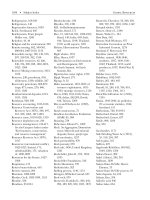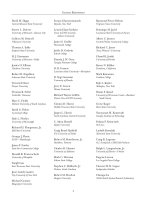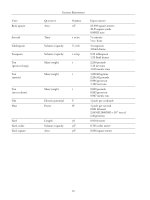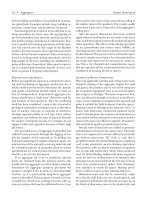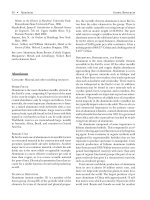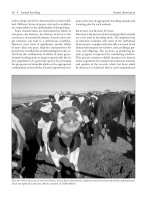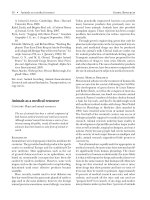Encyclopedia of Global Resources part 16 docx
Bạn đang xem bản rút gọn của tài liệu. Xem và tải ngay bản đầy đủ của tài liệu tại đây (210.84 KB, 10 trang )
gradually blend into one another. The biome concept
finds use in the biosphere reserve program, which is
based on environmental planning aimed at saving
substantial portions of each unique biome.
Energy Entering the Biosphere
The biosphereconceptservesan accountingfunction
by placing all living systems on one enclosed “space-
ship Earth”—a concept that became far easier for the
public to visualize when the space program provided
actual photographs of Earthas a planet. It became ob-
vious that energy input was limited and that nutrients
must be recycled. The Earth intercepts about 2.5 bil-
lion billion horsepower of energy per year as sunlight.
Most reflects back into space or temporarily heats sur-
faces. Because photosynthetic leaves and algae inter-
cept less than 1 percent of this light, there is a limit on
the amount of plant life that can be supported and on
the amount of animal life and decomposers that can
be fed. Ecologists have estimated that the maximum
amount of living tissue (both animals and plants) that
can be supported in the biosphere each year is about
370 billion metric tons, consisting of about 260 billion
metric tons of plants and 110 billion metric tons of
consumers.
Cycles in the Biosphere
Water in the biosphere is stable at about 1.5 billion cu-
bic kilometers, all but 3 percent of which is salt water
in oceans. Three-quarters of fresh water has been esti-
mated to be frozen in glaciers and polar ice caps. The
Earth’s water cycle (hydrologic cycle), then, involves
less than 1percentof the total water, which evaporates
from ocean surfaces or transpires through plant leaves
and then precipitates back down as rain, snow, and so
on. While water is involved in the photosynthesis reac-
tion, water is far more important in plant transpira-
tion, where on average a hundred units of water must
flow through a plant to produce one unit of plant tis-
sue. More than any other factor, the pace of the water
cycle and the unevendistributionofwateraccount for
the variation in vegetation zones on the Earth’s land
surfaces.
In addition to the hydrogen and oxygen in water,
all organisms use carbon, nitrogen, phosphorus, sul-
fur, sodium, potassium, and many other elements.
Whereas water may evaporate and condense back
down in an average of ten days, carbon may take a de
-
cade to cycle. In the atmosphere, 635 billion metric
tons of carbon exist as carbon dioxide. Green plants
convert a portion into carbon in plant tissues on land
(408 billion metric tons) or in phytoplankton (4.5 bil-
lion metric tons) each year. Decomposition returns
some carbon in dead organic matter (408 billion met-
ric tons) to the atmosphere as carbon dioxide, while
some dead organic matter sinks to become part of a
huge sediment repository (18 million billion metric
tons). Coal and oil represent stored carbon from ear-
lier photosynthesis that is rapidly released into the at-
mosphere when fossil fuels are burned. With about 5
billion metric tons of fossil carbon released into the
atmosphere each year, a dramatic increase in atmo-
spheric carbon dioxide would be expected. However,
the ocean appears to be a sink that can absorb excess
carbon dioxide and buffer these fluctuations.
Oxygen is a vital element that cycles through many
complex molecules. In general, however, atmospheric
oxygen gas molecules find themselves cycled through
plants by photosynthesis about every two thousand
years. Oxygen in atmospheric carbon dioxide is re-
spired by plants about once every three hundred
years. Nitrogen makes up 70 percent of the atmo-
sphere, but it must be combined with hydrogen or
oxygen before it can be incorporated into plants. By
cultivating legumes (beans and related plants) andin-
dustrially “fixing” nitrogen, humans have boosted the
amount of nitrogen fixation in the nitrogen cycle by
10 percent. The amount of fixed nitrogen introduced
to the biosphere each year exceeds that which is
denitrified, with the difference likely building up in
groundwater, rivers, lakes, and oceans.
The biosphere concept is too broad to be useful in
most modern ecological research, with ecologists spe-
cializing in detailing specific ecosystems, refining en-
ergy flow budgets, or calculating biogeochemical cy-
cles. However, the concept still finds use in biology
textbooks for defining the limits where life is physi-
cally possible. Combining the studies of the large-
scale cycles allows scientists to assemble the “big pic-
ture” of the biosphere.
John Richard Schrock
Further Reading
Huggett, Richard John.TheNaturalHistory of the Earth:
Debating Long-Term Change in the Geosphere and Bio-
sphere. New York: Routledge, 2006.
Lovelock, James. Gaia: A New Look at Life on Earth. New
York: Oxford University Press, 2000.
_______. The Vanishing Face of Gaia: A Final Warning.
New York: Basic Books, 2009.
120 • Biosphere Global Resources
Rambler, MitchellB.,Lynn Margulis, andRenéFester,
eds. Global Ecology: Towards a Science of the Biosphere.
Boston: Academic Press, 1989.
Samson, Paul R., and David Pitt, eds. The Biosphere and
Noosphere Reader: Global Environment, Society, and
Change. New York: Routledge, 1999.
Smil, Vaclav. The Earth’s Biosphere: Evolution, Dynamics,
and Change. Cambridge, Mass.: MIT Press, 2002.
Trudgill, Stephen. The Terrestrial Biosphere: Environ-
mental Change, Ecosystem Science, Attitudes, and Val-
ues. New York: Prentice Hall, 2001.
See also: Atmosphere; Biosphere reserves; Ecosys-
tems; Geochemical cycles; Greenhouse gases and
global climate change; Lithosphere; Nitrogen cycle;
Oceans; Oxygen; Soil; Water.
Biosphere reserves
Category: Ecological resources
Date: Developed 1974; revised 1995
The biosphere reserve network is an international con-
servation initiative under the United Nations Educa-
tional, Scientific and Cultural Organization’s
(UNESCO’s) program on Man and the Biosphere
(MAB). It designates legally protected mosaics of eco-
logical systems.
Background
Although the original concept of biosphere reserves
was first discussed in 1968 at UNESCO’s Biosphere
Conference, it did not become a formal designation
until 1974, when UNESCO developed the biosphere
reserve designation under the MAB program. The
biosphere reserve designation was intended to set
aside combinations of terrestrial, coastal, and marine
ecosystems for conversation and management to
maintain biodiversity. Unlike many conservation sys-
tems, the biosphere reserve system is specifically in-
tended to encourage research into and implementa-
tion of sustainable human use of resources. The
biosphere reserve network was launched in 1976 and
grew rapidly. In 1983, the First International Bio-
sphere Reserve Congress in Minsk, Belarus, gave rise
in 1984 to an Action Plan for Biosphere Reserves.
The program was significantly revised in 1995 at
the International Conference on Biosphere Reserves
in Seville, Spain, when the World Network of Bio
-
sphere Reserves (WNBR) was established. The Ma-
drid Action Plan agreed upon at the Third World
Congress of Biosphere Reserves in 2008 built further
upon the Seville Strategy.
The WNBR consists of more than five hundred
sites in more than 105 countries. Biosphere reserves
consist of a core, conservation-only zone, a buffer
zone that allows certain ecologically sound practices,
and a transition zone where sustainable resource use
is permitted within the parameters of international
agreements such as Agenda 21 and the Convention
on Biological Diversity.
Reserves are nominated to the WNBR by national
governments according to a set of criteria and condi-
tions. Many biosphere reserves overlap with other
types of protected areas, such as national parks and
UNESCO World Heritage sites. In the United States,
for example, many biosphere reserves are under the
management of the U.S. National Park Service. These
include Big Bend National Park, Denali National
Park, Glacier National Park, Rocky Mountain Na-
tional Park, Virgin Islands National Park, and Isle
Royale National Park, among others.
The United States, China, Russia, and Spain have
the largest number of biosphere reserves. Some re-
serves cross international borders. While nearly all
reserves follow the three-zone scheme, they are man-
aged in a wide variety of ways and with varying confor-
mation to the guidelines set out by UNESCO.
Provisions
The MAB has three main objectives: to contribute to
minimizing biodiversity loss, to promoteenvironmen-
tal sustainability through the WNBR, and to enhance
linkages between culturalandbiologicaldiversity.Un-
der the first objective, the program focuses on a broad
interdisciplinary research agenda examining the eco-
logical, social, and economic impacts of biodiversity
loss. Along with this, a network of learning centers for
integrated ecosystem management was developed.
In specific biosphere reserve contexts, emphasis is
placed on linkages between biodiversity conservation
and socioeconomic development. These strengthen
knowledge of environmental sustainability, including
the sustainable use of natural resources for local com-
munities.
Finally, the program provides special attention to
cultural landscapes and sacred sites, particularly bio
-
sphere reserves and World Heritage sites. It seeks to
Global Resources Biosphere reserves • 121
establish a knowledge base on cultural practices and
traditions that involve local-level sustainable use of
biodiversity in biosphere reserves.
Biosphere reservesare used to test new approaches
to managing nature and human activities, connecting
conservation, development, research, monitoring,
and education. The core area or areas are traditional
conservation areas for preserving biodiversity, moni-
toring minimally disturbed ecosystems, conducting
nondestructive research, and other low-impact uses.
The core areas are surrounded by a buffer zone,
which is used more extensively for environmental ed-
ucation, ecotourism, and a wider range of research.
Finally, this is surrounded by a flexible transition area,
which may include settlements and agricultural activi-
ties. In the transition area, local communities work
with management agencies, scientists, and others to
develop and manage resources with the intention of
sustainability.
The Seville Strategy for Biosphere Reserves, out-
lined in 1995, has as its objectives to improve the cov-
erage of naturalandcultural biodiversity (I.1), to inte-
grate biosphere reserves into conservation planning
(I.2), to secure the support and involvement of local
people (II.1), to ensure better harmonization and in-
teraction among different biosphere reserve zones
(II.2), to integrate biosphere reserves into regional
planning (II.3), to improve knowledgeofinteractions
between humans and the biosphere (III.1), to im-
prove monitoring activities (III.2), to improve educa-
tion, public awareness, and involvement (III.3), to im-
prove training for specialists and managers (III.4), to
integrate the functions of biosphere reserves (IV.1),
and to strengthen the WNBR (IV.2). The three goals
of the Convention on Biological Diversity are to con-
serve biodiversity, to use its components sustainably,
and to share equitably the benefits related to genetic
resources.
122 • Biosphere reserves Global Resources
A ship navigates Chile’s Northern Patagonia Ice Field, a UNESCO World Biosphere Reserve. (AFP/Getty Images)
Impact on Resource Use
The WNBR has played a major role in encouraging
and supporting sustainable development and agri-
culture initiatives as well as in encouraging conser-
vation projects that protect natural resources. The
Madrid Action Plan of 2008 aims to make biosphere
reserves the principal internationally designated
areas dedicated to sustainable development. Socio-
economic development is a key function of transition
areas.
At the Fourth World Congress on National Parks
and Protected Areas, held in 1992 in Caracas, Vene-
zuela, many managers of protected areas adopted
practices similar to those used for the biosphere re-
serve network. Biosphere reserve use ranges from sus-
tainable agriculture and subsistence hunting to tour-
ism, and conservation practices can enhance those
uses. For example, the Hawaiian Islands biosphere
reserve (which encompasses Haleakala and Hawaii
Volcanoes National Parks) has been a key part of
initiatives to remove nonnative species such as feral
pigs and the extremely invasive velvet tree (Miconia
calvescens). Protecting Hawaii’s unique and fragile
ecosystem is important not only for science and biodi-
versity but also for Hawaii’s tourism industry.
Another example of common biosphere reserve
activities can be found in the North Norfolk Coast
Biosphere Reserve in the United Kingdom. In addi-
tion to tourism, environmental education, and scien-
tific research, this reservesupports cultivation of cere-
als and sugar beets, harvesting of shellfish, and some
commercial shore-netting. Sarali Lands Between
Rivers Biosphere Reserve in Russia allows traditional
activities such as plant gathering, fishing, and hay-
making and a variety of sustainable forestry and agri-
culture activities in the buffer zone, including bee-
keeping and hunting. More than sixteen hundred
people live in this region.
Most biosphere reserves have not achieved the
ideal goals of sustainable resource use, but are viewed
as a tool to encourage sustainable resource use and
development in the future. Managers hope that
through sustainable resource use, ecotourism, and
ecologically based industries, local living standards
can be raised while preserving ecological biodiversity.
In some reserves, efforts have already made signifi-
cant change. For example, the Seaflower Biosphere
Reserve in the San Andrés archipelago was developed
by local communities to emphasize ecotourism and
revive traditional subsistence agriculture and arti
-
sanal fishing. These efforts help protect the fragile
coral reefs from threats from poorly planned urban
development, mass tourism, and other issues.
However, not all biosphere reserves have been suc-
cessful in protecting the core areas from illegal activi-
ties such as poaching. This is a particular concern in
countries facing political instability and widespread
poverty. For example, Volcans Biosphere Reserve in
Rwanda faces expanding agricultural areas, poaching
of gorillas, illegal wood and bamboo cutting, and
overgrazing.
Also, application of the biosphere reserve frame-
work has not been equally successful in all countries.
For example, the biosphere reserve designation in
Russia is largely a formality, and Russian biosphere re-
serves function very similarly to regular scientific na-
ture reserves (zapovedniks) in that there is very little
human use of resources.
Because of the international nature of the bio-
sphere reserves and the variance in local manage-
ment, the biosphere reserve designation forms a loose
guideline or goal implemented in many different
ways and with differing degrees of success. However,
its focus on integrating conservation, science, educa-
tion, and sustainable resource use is notable and has
produced avaluableknowledge base for futureefforts
toward sustainable development.
Melissa A. Barton
Further Reading
Hadley, Malcolm, et al. Biosphere Reserves: Special Places
for People and Nature. Paris: UNESCO, 2002.
Mose, Ingo. Protected Areas and Regional Development in
Europe: Towards a New Model for the Twenty-first Cen-
tury. Burlington, Vt.: Ashgate, 2007.
Peine, John D. Ecosystem Management for Sustainability:
Principles and Practices Illustrated by a Regional Bio-
sphere Reserve Cooperative. Boca Raton, Fla.: Lewis,
1999.
United Nations Educational, Scientific and Cultural
Organization. Man and the Biosphere Series. Park
Ridge, N.J.: Parthenon, 1989- .
U.S. National Committee for Man and the Biosphere.
Biosphere Reserves in Action: Case Studies of the Ameri-
can Experience. [Washington, D.C.]: The Program,
[1995].
See also: Biomes; Biosphere; Ecology; Ecosystems;
Ecozones and biogeographic realms; Endangered
species.
Global Resources Biosphere reserves • 123
Biotechnology
Category: Scientific disciplines
Biotechnology is the use of living organisms, or sub-
stances obtained from these organisms, to produce
products or processes of value to humanity.
Background
Modern biotechnological advances have provided the
ability to tap into a natural resource, the world gene
pool, with such great potential that its full magnitude
is only beginning to be appreciated. Theoretically, it
should be possible to transferoneormore genes from
any organism in the world into any other organism.
Because genes ultimately control how any organism
functions, gene transfer can have a dramatic impact
on agricultural resources and human health in the
future.
Although the term “biotechnology” is relatively
new, the practice of biotechnology, according to the
foregoing definition, is at least as old as civilization.
Civilization did not evolve until humankind learned
to produce food crops and domesticate livestock
through the controlled breeding of selected plants
and animals. Eventually humans began to utilize mi-
croorganisms in the production of foods such as
cheese and alcoholic beverages. During the twentieth
century, the pace of human modification of various
organisms accelerated. Because both the speed and
scope of this form of biotechnology are so different
from what has been historically practiced, it is some-
times referred to as modern biotechnology to dis-
criminate it from traditional biotechnology. Through
carefully controlled breeding programs, plant archi-
tecture and fruit characteristics of crops have been
modified to facilitate mechanical harvesting. Plants
have been developed to produce specific drugs or
spices, and microorganisms have been selected to
produce antibiotics such as penicillin and other use-
ful medicinal or food products.
Developments in Biotechnology
For many years, the methods for selecting desirable
traits in living organisms remained unchanged. In the
early 1900’s, even with the realization that specific
traits are linked with packets of deoxyribonucleic acid
(DNA) called genes (the amount of DNA required to
encode a single protein), scientists remained con
-
strained to the methods of artificial selection in use
throughout history. This changed in the 1970’s, when
techniques were developed both to determine the or-
der of the four possible DNA “bases” (which spell out
the information found in a gene)—a process called
DNA sequencing—and to transfer this gene into an-
other organism. The use of modern biotechnology in
crops, livestock, and medicine can be divided into
three major stages: identifying a gene of interest,
transferring this gene into the organism of interest,
and mass-producing the “transgenic” organisms that
have taken up this foreign DNA.
Identification of Genes of Interest
As DNA-sequencing technology progressed, it soon
became possible not only to sequence the DNA found
in individual genes but also to determine the entire
DNA complement of an organism, including its en-
tire set of genes, referred to as its genome. Genome
sequencing, in conjunction with traditional genetic
techniques that allowed traits to be mapped to partic-
ular regions on a chromosome, soon led to a wealth of
information concerning which genes controlled par-
ticular traits. Eventually, by comparing the DNA se-
quences of many different organisms, the role of a
given gene could often be surmised, even if no direct
genetic evidence was available for that particular gene.
In this way genes could be targeted for experimental
manipulation based on their similarity to known
genes. Techniques were then developed in the late
twentieth century that allowed for entire genomes to
be screened for their response to given conditions,
even if the function of individual genes could not be
guessed from existinggeneticdata.Here, the genome
of an organism is broken into roughly gene-sized frag-
ments, which are in turn covalently attached to a glass
slide to create a DNA microarray, or gene chip. These
chips can then be probed with the ribonucleic acid
(RNA) produced by organisms that have been ex-
posed to certain conditions, RNA being the interme-
diate chemical produced by genes prior to the manu-
facture of protein in the cell.
It is ultimately these proteins, in the form of en-
zymes with specific desired activities, or, alternately,
the small organic compounds produced by a specific
enzymatic/metabolic activity, that are the target of
those involved in the pharmaceutical or chemical in-
dustries. The latter are often referred to as secondary
metabolites to denote the fact that they are not strictly
required for the life of a cell but are produced by cer
-
124 • Biotechnology Global Resources
tain types of organisms in order to better adapt to
given situations. Because it remains beyond the scope
of modern DNA-sequencing technology to determine
the genomic sequence of every possible organism
which may be of interest to researchers, or even to cre-
ate DNA microarrays from every such organism, many
have turned to high-throughput screening techniques
to identify proteins or secondary metabolites of bio-
technological interest. Here, many separate cellular
extracts are screened for a desired chemical activity at
the same time,withfurther researchandcharacteriza-
tion carried out on only the positive samples. Robotic
microtiter plate readers have been designed to read
the results of many colorimetric screening assays at
once, significantly increasing the speed and ease of
high-throughput screening. Once a positive sample is
identified, the techniques described above can then
be used to characterize the gene of interest.
Recombinant DNA Technology
Because the DNA of all cells—whether from bacteria,
plants, lower animals, or humans—is very similar,
when DNA from a foreign species is transferred into a
different cell, it functions exactly as the native DNA
functions; that is, it “codes” for protein. The simplest
protocol for this transfer involves the use of a vector,
usually a piece of circular DNA called a plasmid,
which is removed from a microorganism such as bac-
teria and cut open by an enzyme called a restriction
endonuclease or restriction enzyme. A section of
DNA from the donor cell that contains a previously
identified gene of interest is cut out from the donor
cell DNA by the same restriction endonuclease. The
section of donor cell DNA with the gene of interest is
then combined with the open plasmid DNA, and the
plasmid closes with the new gene as part of its struc-
ture. This process is referred to as “cloning” the gene.
The recombinant plasmid (DNA from two sources) is
placed back into the bacteria, where it will replicate
and code for protein just as it did in the donor cell.
The bacteria can be cultured and the gene product
(protein) harvested, or the bacteria can be used as a
vector to transferthegeneto another species, where it
will also be expressed, creating a “transgenic” organ-
ism. Thistransferofgenes (and thereforeofinherited
traits between very different species) has revolution-
ized biotechnology and provides the potential for ge-
netic changes in plants and animals that have not yet
been envisioned.
The basic methodology for recombinant DNA
technology was developed in the 1970’s, when restric
-
tion enzymes were first isolated and began to be used
for this process, but the ease by which the cloning of
genes could take place was greatly increased a decade
later with the development of the polymerase chain
reaction (PCR). DNA polymerase is an enzyme that
can be used to artificially create DNA in the labora-
toryfrom a givenDNAtemplate that hasbeenisolated
from an organism of interest. In the 1980’s, scientists
realized that DNA polymerase isolated from certain
thermophilic organisms—microbes that could exist
at very high temperatures—could be used again and
again in a “chain reaction” to create DNA without be-
ing broken down in the process. Soon, minute quanti-
ties of DNA taken from any given source could be am-
plified using PCR beforebeingtreatedwith restriction
enzymes. Prior to this, relatively large quantities of the
DNA of interest had been required.
Mass Production of Desired Organisms
Once an organism has been transformed using re-
combinant DNA technology, or even if an organism
that has all of the desired characteristics has been iso-
lated from nature for a particular application, the
next step in biotechnology is to produce as many ex-
act copies of that organism as possible. Beginning in
the mid-twentieth century, the ability to utilize artifi-
cial media to propagateplantsledtothe development
of a technology called tissue culture. The earliest
form of tissue culture involved using the culture of
meristem tissue to produce numerous tiny shoots that
can be grown into full-size plants, referred to as whole
organism clones because each plant is genetically
identical. More than one thousand plant species have
been propagated by tissue culture techniques. Plants
have been propagated via the culture of other tissues,
including the stems and roots. In some of these tech-
niques, the plant tissue is treated with the proper
plant hormones to produce callus tissue, masses of
undifferentiated cells. The callus tissue can be sepa-
rated into single cells to establish a cell suspension
culture. Callus tissue and cell suspensions can be used
to produce specific drugs and other chemicals; entire
plants can also be regenerated from the callus tissue
or from single cells.
Numerous advances in animal biotechnology have
also occurred. Artificial insemination, the process in
which semen is collected from the male animal and
deposited into the female reproductive tract by artifi
-
cial techniques rather than natural mating tech
-
Global Resources Biotechnology • 125
niques, has been in use for more than one hundred
years. With this technique, males in species such as
cattle can sire hundreds of thousands of offspring,
whereas only thirty to fifty could be sired through nat-
ural means. Embryo transfer, a procedure in which an
embryo in its early stage of development is removed
from its own mother’s reproductive tract and trans-
ferred to another female’s reproductive tract, is a
technique used to increase the number of offspring
that can be produced by a superior female. Super-
ovulation and embryo splitting have increased the
feasibility of routine embryo transfers. Superovula-
tion is the process in which females that are to serve as
embryo donors are injected with hormones to stimu-
late increased egg production. Embryo splitting is the
mechanical divisionofan embryo intoidenticaltwins,
quadruplets, sextuplets, and so on. Through a combi-
nation of artificial insemination, superovulation, em-
bryo splitting, and embryo transfer, it is possible for
the sperm from a superior male to be used to fertilize
several ovules (each of which can then be split into
several offspring) from a superior female. All the re-
sulting embryos can then be transferred to the repro-
ductive tracts of inferior surrogate females.
As notedpreviously, clones ofplantshavebeen pro-
duced through the use of meristem tissue for some
time. The far morecomplexcloningofplants and ani-
mals from the DNA of a single cell is a more recent
development. Producing copies of organisms by this
method has long been viewed as a prospective
method of improving agricultural stock. Proponents
have also suggested that cloning technology might be
used to regenerate endangered species. Even such ap-
parently benign ideas have had their detractors, how-
ever, ascriticshave noted the potentialdangersofnar-
rowing a species’ genetic pool. The July, 1996, birth in
Scotland of Dolly the sheep, the first cloned mammal,
demonstrated that the cloning of animals had left the
realm of science fiction and become a matter of scien-
tific fact. However, Dolly’s premature death at age six,
about half the life expectancy of a normal sheep, sig-
naled the scientific community that there was still
much to be learned about the aging process. Dolly
had contracted a progressive lung disease, along with
arthritis. Both maladies are typically associated with
much older sheep.
Biotechnology in Crop Production
Biotechnology will undoubtedly continue to have a
tremendous impact on agriculture in the future. Ex-
perts who study human populations predict that the
number of human inhabitants on Earth will reach
alarming proportions by the mid-twenty-first century.
The only way in which civilization can continue to ad-
vance, orevenmaintain a steady state,
in the face of this potential disaster
will be to increase food production,
and biotechnology will most likely
play an important role in produc-
ing this increase. Increased food pro-
duction has been dependent on de-
velopments such as crop plants that
produce higher yields under normal
conditions and crops that produce
higher yields when grown in mar-
ginal environments.
Even under the best of situations,
there is a limited amount of land
available for crop production, and
while the number of people that have
to be fed will continue to increase,
the amount of good agricultural land
will remain the same or decrease. If
mass starvationistobeavoided, crops
with higher yields will have to be de
-
veloped and grown on the available
land. As human populations con
-
126 • Biotechnology Global Resources
OriginOil cofounderNicholas Eckelberry standsbeside containersof algaethat he and his
company hope can be used as a biofuel source. (Reuters/Landov)
tinue to grow, good agricultural lands are taken over
for industry, housing developments, and parking lots.
As nonrenewable sources of energy—notably fossil fu-
els—are depleted, more land will be diverted to pro-
duce cellulosic material devoted to fuel production
(the diversionofcorn crops for ethanolproduction in
the early twenty-first century is one example). The
continuation of this trend will require that crops be
grown on marginal lands where soil and growth con-
ditions are less than ideal. The only way to increase
crop production is to develop stress-tolerant plants
that produce higher yields when grown under these
marginal conditions. While the development of these
higher-yielding crops could probably be accomplished
though traditional breeding programs, the traditional
methods are too slow to keep pace with the rapidly in-
creasing population growth. Biotechnology provides
a meansofdeveloping these higher-yielding cropsina
fraction of the time it takes to develop them though
traditional plant breeding programsbecausethegenes
for the desired characteristics can be inserted directly
into the plant without having to go through several
generations to establish the trait.
Economically, there is often a need or desire to di-
versify agricultural production in a given area. In
many cases, soil and/or climate conditions may se-
verely limit the amount of diversification that can take
place. A producer might wish to grow a particular
high-value cash crop, but environmental conditions
may prevent the producer from doing so. Biotechnol-
ogy can provide the tools to help facilitate a solution
to these types of problems. For example, high-cash-
value crops can be developed to grow in areas that
heretofore would not have supported such crops. An-
other approach would be to increase the cash value of
a crop by developing plants that can produce novel
products such as antibiotics, drugs, hormones, and
other pharmaceuticals. Progress toward the produc-
tion of specific proteins in transgenic plants provides
opportunities to produce large quantities of complex
pharmaceuticals and other valuable productsin tradi-
tional farm environments rather than in laboratories.
These novel strategies open up routes for production
of a broad array of natural or nature-based products,
ranging from foodstuffs with enhanced nutritive value
to the production of biopharmaceuticals, monoclonal
antibodies, industrial proteins, and specialist oils. Crop
plants that have been bioengineered to produce novel
products may have a much higher cash value than the
crop in its natural state.
Biotechnology and the Environment
While there will be a growing pressure for agriculture
to produce more food in the future, there will also be
increased pressure for crop production to be more
friendly to the environment. Biotechnology plays a
major role in the development of a long-term, sustain-
able, environmentally friendly agricultural system. For
example, one of the major biotechnical goals is the
development of crops with improved resistance to
pests such as insects, fungi, and nematodes. The avail-
ability of crop varieties with improved pest resistance
in turn reduces the reliance on pesticides. In conjunc-
tion with the improvements made through biotech-
nology, improved methods of crop production and
harvest with less environmental impact will also have
to be developed. Regardless of the technological ad-
vancements madeinpestresistance, crop production,
and harvest, agriculture will continue to have an im-
pact on the environment. Agricultural pollutants will
still be present, though perhaps in reduced amounts,
and the need to remediate these polluting agents will
continue to exist. Hence, biotechnology will play an
important role in the development of bioremediation
systems for agriculture as well as other industrial pol-
lutants.
Biotechnology in Livestock Production
Biotechnology also plays an important role in live-
stock production. A gene product called bovine so-
matotropin, or BST, a hormone that stimulates growth
in cattle, was one of the first proteins to be harvested
from recombinant bacteria and given to dairy cattle
to enhance milk production. The application of bio-
technology to living organisms, especially to animals,
has not been without controversy, however. Critics of
the use of BST in cattle raised concerns about the
health and well-being of the cows that had to be sub-
jected to repeated injections in order to boost milk
production and pointed to the presence of small
quantities of this hormone, as well as a related hor-
mone called IGF-1, in the milk produced by these
cows. Despite a wealth of scientific evidence that these
hormones posed no threat to humansandwere in fact
destroyed during the process of digestion, public con-
cern led a majority of companies to eventually discon-
tinue the use of BST treatment. Assuming that public
concerns are sufficiently addressed, future experimen-
tation may lead to increased productivity and, at the
same time, a reductioninthe cost of production of an
-
imal products. As with plants, disease-resistant ani
-
Global Resources Biotechnology • 127
mals are being genetically engineered, and parasites
are being controlled by genetic manipulation of their
physiology and biochemistry. Animals, like plants,
have been genetically engineered to produce novel
and interesting products such as pharmaceuticals.
Biotechnology in Medicine
While recombinant technology has already had an in-
direct influence on human well-being through its ef-
fects on plants and livestock, it will probably also have
a dramatic, direct impact on human health. Recombi-
nant DNA technology can be used to produce a vari-
ety of gene products that are utilized in the clinical
treatment of diseases. A number of human hormones
produced by this methodology have been in use for
some time. Human growth hormone (HGH), mar-
keted under the name Protropin, was one of the first
recombinant proteins to be approved by the U.S.
Food and Drug Administration, in this case to treat a
disease called hyposomatotropism. People suffering
from this disease do not produce enough growth hor-
mone and without treatment with HGH will not reach
normal height. Insulin, a hormone used to treat insu-
lin-dependent diabetics, was the first major success in
using a product of recombinant technology. Begin-
ning in 1982, recombinant DNA-produced insulin,
marketed under the name Humalin, has been used
to treat thousands of diabetic patients. A pituitary
hormone, called somatostatin, was another early suc-
cess of recombinant DNA techniques. This hormone
controls the release ofinsulinandhumangrowth hor-
mone. Some of the interferons, small proteins pro-
duced by a cell to combat viral infections, have also
been produced using recombinant DNA methodol-
ogy. The technology could thus be used to produce
vaccines against viral diseases. The first of these vac-
cines, marketed under the nameRecombivaxHB,was
successfully used to vaccinate against hepatitis B, an
incurable and sometimes fatal liverdisease.Anumber
of other antiviral vaccines were soon developed.
Advances in biotechnology have also enhanced the
potential for the future application of gene therapy.
Genetic therapy is often defined as any procedure
that prevents, reduces, or cures a genetic disease, but
for this discussion the term gene therapy will apply
only to those procedures that involve the direct ma-
nipulation of human genes. The following forms of
gene therapy are in development: gene surgery, in
which a mutant gene (which may or may not be re
-
placed by its normal counterpart) is excised from the
DNA; gene repair, in which the defective DNA is re
-
paired within the cell to restore the genetic code; and
gene insertion, in which a normal gene complement
is inserted in cells that carry a defective gene.
Although both gene repair and gene surgery have
been performed in viruses, bacteria, and yeast, the
techniques remain too complex to be used on hu-
mans, at least in the near future. Gene insertion, how-
ever, has been attempted in a variety of human cells.
This processcanpotentially be done ingerm-line cells
(such as the egg or sperm), the fertilized ovum or
zygote, the fetus, or the somatic cells (a nonrepro-
ductive cell) of children or adults. Of these catego-
ries, germ-line therapy remains the most controver-
sial because it has potential to alter permanently the
genetic makeup of future generations. Zygote ther-
apy holds perhaps the most promise because through
it completely normal individuals could potentially be
produced, but gene insertion in zygotes is still a very
complex undertaking and will likely not be practiced
in the near future. Somatic gene therapy, however,
has been applied in humans to a limited extent for
many years. A decade after the 1990 success of human
gene therapy to treat severe combined immunodefi-
ciency (SCID), sometimes called “bubble boy” dis-
ease, the death of Jesse Gelsinger, an eighteen-year-
old who was undergoing an experimental procedure
to treat a non-life-threatening liver condition, put ad-
ditional gene therapy trials on hold. Early in the
twenty-first century, human gene therapy trials cau-
tiously resumed, with most trials targeting the inser-
tion of a gene into the cells of a tissue that is most in-
fluenced by a defective gene, followed by tests to
determine whether the inserted gene was able tocode
for sufficient gene product to alleviate the symptoms
of the disease.
Ownership Issues
Many difficult ethical and economic issues surround-
ing the use of modern biotechnology remain. One of
the major questions concerns ownership. The U.S.
patent laws currently read that ownershipofan organ-
ism can be granted if the organism has been inten-
tionally genetically altered through the use of recom-
binant DNA techniques. In addition, processes that
utilize genetically altered organisms can be patented.
Therefore one biotechnology firm may own the pat-
ent to an engineered organism, but another firm may
own the rights to the process used to produce it.
D. R. Gossett, updated by James S. Godde
128 • Biotechnology Global Resources
Further Reading
Campbell, Neil A., and Jane B. Reece. Biology. 8th ed.
San Francisco:Pearson/BenjaminCummings, 2008.
Chrispeels, Maarten J., and David E. Sadava. Plants,
Genes, and Crop Biotechnology. 2d ed. Boston: Jones
and Bartlett, 2003.
Field, Thomas G., and Robert E. Taylor. Scientific Farm
Animal Production: An Introduction to Animal Science.
9th ed. Upper Saddle River, N.J.: Prentice Hall,
2008.
Holdrege, Craig, and Steve Talbott. Beyond Biotechnol-
ogy: The Barren Promise of Genetic Engineering. Lex-
ington: University Press of Kentucky, 2008.
Kreuzer, Helen, and Adrianne Massey. Molecular Biol-
ogy and Biotechnology: A Guide for Students. 3d ed.
Washington, D.C.: ASM Press, 2008.
Lewis, Ricki. Human Genetics: Concepts andApplications.
7th ed. Boston: McGraw-Hill Higher Education,
2007.
Mousdale, David M. Biofuels: Biotechnology, Chemistry,
and Sustainable Development. Boca Raton, Fla.: CRC
Press, 2008.
Reiss, Michael J., and Roger Straughan. Improving Na-
ture? The ScienceandEthics of Genetic Engineering. Cam-
bridge, England:CambridgeUniversity Press, 2001.
Renneberg, Reinhard. Biotechnology for Beginners. Edited
by Arnold L. Demain. Berlin: Springer, 2008.
Taylor, Robert E., and Thomas G. Field. Scientific Farm
Animal Production. 9th ed. Upper Saddle River, N.J.:
Pearson Prentice Hall, 2008.
Thieman, William J., and Michael A. Palladino. Intro-
duction to Biotechnology. 2d ed. San Francisco:
Pearson/Benjamin Cummings, 2009.
Yount, Lisa. Biotechnology and Genetic Engineering.3d
ed. New York: Facts On File, 2008.
See also: Agricultural products; Agriculture indus-
try; Animal breeding; Animal domestication; Animals
as a medical resource; Genetic diversity; Plant domes-
tication and breeding; Plants as a medical resource.
Bismuth
Category: Mineral and other nonliving resources
Where Found
Bismuth is a rare element in the Earth’s crust, with an
abundance roughly equaltothatof silver. It is also one
of the few metallic elements that can be found in na
-
ture in its elemental form. As such it is often found in
the same areas as lead, zinc, or tin deposits in loca-
tions such as Bolivia, Canada, and Germany. In addi-
tion, it occurs in ores as an oxide, sulfide, or carbon-
ate. Rather than being mined and refined directly,
bismuth is obtained commercially as a by-product of
copper, lead, and zinc refining operations. Leading
producers are China, Mexico, and Belgium.
Primary Uses
Bismuth and its compounds are used in pharmaceuti-
cal applications as well as in severalcommercial chem-
ical syntheses. By far the main commercial use of bis-
muth is as an alloying agent.
Technical Definition
Bismuth (atomic symbol Bi) has an atomic number
of 83 and is found in the nitrogen group (main
Group V) of the periodic table. It is similar to anti-
mony in its chemical properties but has significantly
greater metallic behavior than the other elements in
Global Resources Bismuth • 129
Fusible alloys,
solders, &
cartridges
46%
Metallurgical
additives
17%
Pharmaceuticals
& chemicals
35%
Other 2%
Source:
Historical Statistics
for Mineral and Material Commodities in the United States
U.S. Geological Survey, 2005, bismuth statistics, in
T.D.KellyandG.R.Matos,comps.,
,
U.S. Geological Survey Data Series 140. Available
online at />U.S. End Uses of Bismuth
